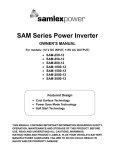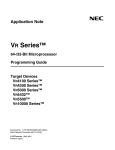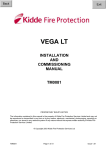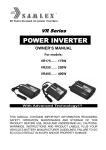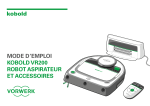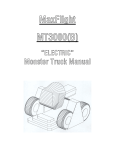Download Samlexpower SI-A1-VR2000 Owner`s manual
Transcript
SAM LEX 20 Years focused on power inverters VR Series POWER INVERTER OWNER’S MANUAL For models (115V): SI-A1-VR1500 SI-A1-VR2000 SI-A1-VR3000 With Advanced Technology!!! THIS MANUAL CONTAINS IMPORTANT INFORMATION REGARDING SAFETY, OPERATION, MAINTENANCE AND STORAGE OF THIS PRODUCT. BEFORE USE, READ AND UNDERSTAND ALL CAUTIONS, WARNINGS, INSTRUCTIONS AND PRODUCT LABELS, PLUS YOUR VEHICLE’S BATTERY MANUFACTURER GUIDELINES. FAILURE TO DO SO COULD RESULT IN INJURY AND/OR PROPERTY DAMAGE. IMPORTANT SAFETY INSTRUCTIONS To ensure reliable service, your power inverter must be installed and used properly. Please read the installation and operating instructions thoroughly prior to installation and use. Pay particular attention to the WARNING and CAUTION statements in this manual. The CAUTION statements advise against certain conditions and practices that may result in damage to your inverter. The WARNING statements identify conditions or practices that may result in personal injury. Read All Instructions Before Using This Power Inverter! WARNINGS: TO REDUCE THE RISK OF FIRE, ELECTRIC SHOCK, EXPLOSION OR INJURY: 1. Do not connect to AC distribution wiring. 2. Remove appliance plug from outlet strip or turn off inverter before working on the appliance. Multiple outlet power strips with switches and circuit breakers only interrupt power to the “hot” receptacle terminals. The “neutral” terminals remain powered with respect to the “ground” terminals. 3. Do not make any electrical connections or disconnections in areas designated as IGNITION PROTECTED. This includes 12 V DC cigarette plug connections, and terminal connections. 4. This is not a toy - keep away from children. 5. DO NOT install object into air vents. CAUTIONS: 1. Do not use with positive ground electrical systems (the majority of modern automobiles, RVs, trucks and boats are negative ground). Reverse polarity connection will result in a blown fuse and may cause permanent damage to the inverter. 2. This inverter will not operate high wattage appliances over the output power limit or surge power limit. 3. Grounding the neutral will cause the inverter to shut down. Do not operate this inverter if it is wet. Do not install in engine compartment – please install in a well ventilated area. 4. This inverter is not tested for use with medical devices. IMPORTANT CABLE INFORMATION Substantial power loss and reduced battery operating time results from inverters installed with cables that are not able to supply full power. Symptoms of low battery power can result from cables that are either excessively long or an insufficient gauge. The installer/operator should be especially aware of the requirements to maintain secure, tight, water-resistant electrical connections and to provide for strain relief for DC cables and appliance wiring. Cable insulation must be the appropriate type for the environment. 2 1. INTRODUCTION Your new SAMLEX VR-Series power inverter is one in a series of the most advanced DC to AC inverters available today. With proper care and appropriate usage, it will give you years of dependable service in your car, truck, RV or boat. VR series inverters designed with a universal protection circuit that provide added safety features include automatic shutdown, earth fault protection and a low battery alarm to prevent damage to your battery. This power inverter is configured with the latest low interference technology (L.I.T.), Universal Protection Circuit (UP-Circuit) and Soft Start circuit to improve inverter operation. UP-Circuit provides full automatic inverter and battery protection. This includes overheat protection, battery protection, overload protection, short circuit protection and earth fault protection. L.I.T. greatly improves the interference problems of common power inverter. Before introduction of L.I.T., signal interference may occur on TV pictures, audio system or radio equipments. Now you can enjoy a clean and powerful AC source! Soft Start Circuit provides three major features. First, gradual voltage ramp-up during inverter start-up. This eliminates failed cold starts under load. Second, output that momentarily dips in voltage and quickly recovers. This eliminates most shutdowns from momentary overloads. 3 2. HOW YOUR INVERTER WORKS The inverter converts low voltage DC (Direct Current) from a battery or other power source to 115 volt AC (Alternating Current) household power. PRINCIPLE OF OPERATION The inverter converts power in two stages. The first stage is a DC to DC conversion process that raises the low voltage DC at the inverter input to higher volts DC. The second stage is the actual inverter stage that converts the high voltage DC into 115 volts, 60 Hz AC(rms). The DC-to-DC converter stage uses modern high frequency power conversion techniques that have replaced the bulky transformers found in less technologically-advanced models. The inverter stage uses advanced power MOSFET transistors in a full bridge configuration. THE OUTPUT WAVEFORM The AC output waveform of the VR-series inverter is known as “modified sine wave”. It is a waveform that has characteristics similar to the sine wave shape of utility power. This type of waveform is suitable for most AC loads, including linear and switching power supplies used in electronic equipment, transformers, and motors. (See Figure 4). The modified sine wave produced by the VR-series inverter has an RMS (root mean square) voltage of 115 volts, which is the same as standard household power. Most AC voltmeters (both digital and analog) are sensitive to the average value of the waveform rather than the RMS value. They are calibrated for RMS voltage under the assumption that the waveform measured will be a pure sine wave. These meters will not read the RMS voltage of a modified sine wave correctly. They will read about 20 to 30 volts low when measuring the output of the inverter. For accurate measurement of the output voltage of this unit, use a true RMS reading voltmeter such as a Fluke 87III, Fluke 8060A, Fluke 77/99 series or Beckman 4410. FIGURE 4 : Modified Sine Wave and Sine Wave Comparison 4 3. INSTALLATION / ENVIRONMENTS POWER SOURCE REQUIREMENTS The power source must provide between 10.5 and 14.5 volts DC and must be able to supply the necessary current to operate the load. The power source may be a battery or a well-regulated DC power supply. To obtain a rough estimate of the current (in amperes) the power source must deliver, simply divide the power consumption of the load (in watts AC) by 10. Example: lf a load is rated at 100 watts AC, the power source must be able to deliver: 100 / 10=10A The inverter will provide you with up to 1.5/2.0/3.0 KVA of continuous, electrical power (3.0/4.0/6.0 KVA peak) at 115 VAC when powered by a 12.5 VDC source such as is found in a vehicle or multiple battery configurations as shown in FIGURE 5. This manual does not describe all of the possible types of battery configurations, battery charging configurations and battery isolation configurations. To properly operate the inverter the DC power source must provide between 11.0 and 14.5 VDC and nominally at 300 Amps. This DC power source must be a well-regulated DC power supply as typically found in vehicular and deep-cycle marine batteries. The DC power source may also be two 12 volt batteries connected in parallel. On larger applications the power source may be several batteries connected in parallel as shown on FIGURE 5. FIGURE 5 5 INSTALLATION NOTES: WARNING: Keeping ventilation when using batteries. Batteries may generate flammable gas during charging or discharging. The inverter has four slots in its mounting bracket that allow the unit to be fastened against a bulkhead, floor, wall or other flat surface. Ideally, the mounting surface should be cool to the touch. It is more electrically efficient to use longer AC wiring than DC wiring, so install the inverter as close as possible to the 12 VDC power source. The inverter can be operated in any position, however, if it is to be mounted on a wall, mount it horizontally so that indicators, switches, outlets and terminal blocks located on the front panel are visible and accessible. If inverter is to be installed in a moving vehicle, we strongly recommends that the inverter be shock-mounted either on the floor (in a clear, safe area) or on a secure flat surface. CAUTION: The inverter must be connected only to batteries with a nominal output voltage of 12volts. The unit will not operate from a 6 volt battery, and will sustain permanent damage if connected to a 24 volt battery. CAUTION: Loose connectors may cause overheated wires and melted insulation. Check to make sure you have not reversed the polarity. Reverse polarity connection will result in a blown fuse and may cause permanent damage to the inverter. CONNECTING TO A POWER SOURCE Use ( #2 AWG for VR1500; 2x #2 AWG for VR2000/3000) wire for if the inverter to power source connection is 1.5 meters or less. For longer cable lengths, consult technician for appropriate cable size. In either case, protect the positive (+) wire from shorts by installing a fuse or circuit breaker close to the DC power source (battery) terminal. The fuse should choose 200A for VR1500, 300A for VR2000, 400A for VR3000. 1. Check to be sure the inverter’s power switch is turned off and that no flammable fumes are present. 2. Identify the positive (+) and negative (-) DC power source (battery) terminals. 3. Install a fuse holder or breaker close to the positive (+) terminal of the DC source (battery). 4. Connect a length of wire on one side of the fuse holder or circuit breaker. Connect the other end if the wire to the positive (+) terminal of the inverter. 6 5. Connect a length of wire between the inverter’s negative (-) terminal and the DC power source negative (-) terminal. 6. Connect a short length of wire to the other terminal of the fuse holder or circuit breaker. Mark it “POSITIVE” or “+”. 7. Connect the free end of the fuse or breaker wire to the positive terminal of the DC power source (battery). 8. Insert a suitable fuse in the fuse holder. 9. Check to be sure that all connections between battery clips, terminals and fuse are secure and tight. 10. Test the inverter by turning it on and plugging in a 100 watt lamp or equipment. 11. If the inverter is not properly operating, then refer to the troubleshooting sections of this manual. CAUTION: Loose connectors may cause overheated wires and melted insulation. CONNECTION TO LOAD The inverter is equipped with two universal AC power receptacles. Plug the cord from the equipment you wish to operate into the AC receptacle. The green LED indicator lights to indicate that the inverter is functioning. Make sure the combined load requirement of your equipment does not exceed inverter’s output rating. The inverter is engineered to be connected directly to standard electrical and electronic equipment in the manner described above. Do not connect the power inverter to household or RV AC distribution wiring. Do not connect the power inverter to any AC load circuit in which the neutral conductor is connected to ground (earth) or to the negative of the DC (battery) source. WARNING: Do not connect to AC distribution wiring. 7 OPERATING ENVIRONMENT For best operating results, the inverter should be placed on flat surface, such as the ground, car floor, or other solid surface. The power cord allows easy positioning of the inverter. The inverter should only be used in locations that meet the following criteria: DRY- Do not allow water and/or other liquids to come into contact with the power inverter. In all marine applications, do not install the inverter below or near the waterline and keep the inverter away from moisture or water. COOL – Ambient air temperature should be between 30 degrees F (-1 degree C) non-condensing, and 105 degrees F (40 degrees C). Do not place the inverter on or near a heating vent or any piece of equipment which is generating heat above room temperature. Keep the inverter away from direct sunlight, if at all possible. VENTILATED – Keep the area surrounding the inverter clear to ensure free air circulation around the unit. Do not place items on or over the inverter during operation. A fan is helpful if the inverter is operating at maximum power outputs for extended periods of time. The unit will shut down if the internal temperature exceeds operating temperatures. The unit will restart after it cools. SAFE – Do not use the inverter near flammable materials or in any locations that may accumulate flammable fumes of gases. 8 4 . OPERATING TIPS RATED VERSUS ACTUAL CURRENT DRAW OF EQUIPMENT Most electrical tools, appliances and audio/video equipment have labels that indicate the power consumption in amps or watts. Be sure that the power consumption of the item you wish to operate is rated at 1500/2000/3000 watts or less. (If the power consumption is rated in amps AC, simply multiply by the AC volts (115) to determine the wattage). Resistive loads are the easiest for the inverter to run. However, larger resistive loads, such as electric stoves or heaters, usually require more wattage than the inverter can deliver. Inductive loads, such as TV’s and stereos, require more current to operate than do resistive loads of the same wattage rating. Induction motors, as well as some televisions, may require 2 to 6 times their wattage rating to start up. The most demanding in this category are those that start under load, such as compressors and pumps. DETERMINING BATTERY SIZE To determine the minimum battery size that you will need to operate appliances from the power inverters, follow these steps: 1. Determine the wattage of each appliance and/or tool you will need to simultaneously operate from the inverter. To do this, read the labels on the equipment to be operated. Usually, power consumption is shown in watts. If it is shown in amps, multiply by 115 to determine the wattage. 2. Estimate the number of hours the equipment will be in use between battery recharges. 3. Determine the total watt-hours of energy use, the total running time and the average power consumption. To get an estimate of the current (in amps) that the battery must be capable of delivering, divide the load consumption power (in watts) by (10). Keep in mind that most appliances are not operating for long periods of time. For example, a typical home-use coffee maker draws 500 watts during its brew time of 5 minutes, but it maintains the temperature of the pot at about 100 watts. Typical use of a microwave is only for a few minutes, sometimes at low power. Some exceptions to brief operating times are lamps, TVs and computers. In most instances, the inverter can be left connected to the battery when not in use, make sure power switch is in the OFF position. 9 5. PROTECTIVE FEATURES OF THE INVERTER Your inverter monitors the following potentially hazardous conditions: OVER TEMPERATURE PROTECTION – If the temperature inside the inverter is too high, the unit will automatically shut down. Allow the unit to cool for at least 15 minutes before restarting after a heat-related shutdown. Unplug unit while cooling. LOW BATTERY VOLTAGE PROTECTION - This condition is not harmful to the inverter but could damage the power source. The inverter automatically shuts down when input voltage drops to 10.5 volts. When the condition is corrected, the unit may be restarted. OVER VOLTAGE PROTECTION – The inverter will automatically shut down when the input voltage exceeds 15 volts DC. Input voltage exceeds 16 volts could damage the inverter. OVERLOAD PROTECTION – The inverter will automatically shut down when the continuous draw exceeds rated watts. SHORT CIRCUIT PROTECTION – The inverter will shut down. EARTH FAULT PROTECTION – This inverter comply with the standard current leakage allowance. When large current leakage to earth terminal occurs, the protection circuit activated and shut down the inverter, which prevent electric shock to human. Turn OFF the inverter, unplug the fault AC appliance and then turn ON is the only way to restart it. LOW BATTERY ALARM – An alarm will sound when the voltage from the battery drops to 10.9 volts. This is an indication that the battery needs to be recharged. The user should stop operation of the electronic device at this time since the inverter will shut down automatically shortly thereafter. Start your engine to recharge the battery. If the low voltage alarm sounds when the battery is fully charged, follow the steps for solving lack of output power in the Troubleshooting guide. The alarm may sound when the inverter is overloaded, in thermal shutdown, or if there is an excessive voltage drop between the battery and inverter. NOTE: It is normal for the alarm to sound while the unit is being connected to, or disconnected from, the power source. This is not indicative of a problem. 10 6 COMMON PROBLEMS POWER TOOLS AND MICROWAVE OVENS WON’T START Read the information panel on each power tool carefully to accurately determine the tool’s input wattage. The wattage output is sufficient to operate most power tools and microwave ovens but remember that the power needed to start the power tool may be as much as 2 to 6 times its continuous wattage requirements. “BUZZING” SOUND IN AUDIO SYSTEMS: Some inexpensive stereo systems and “boom boxes” emit a buzzing sound from their speakers when operated from the power inverter. This occurs because the power supply in the electronic device does not adequately filter the modified sine wave produced by the inverter. The only solution to this problem is to use a higher quality sound system that incorporates a higher quality power amplified supply. TELEVISION INTERFERENCE: The inverter is designed to minimize interference with TV signals. The problem may not be with the inverter. However, in some instances, some interference may still be visible, particularly with weak TV signals. Try the following corrective measures: - Position the inverter as far as possible from the television, the antenna and the antenna cables. Use an extension cable, if necessary. - Adjust the orientation of the inverter, the antenna cables and the TV power cord to minimize interference. - Make sure that the antenna feeding the television provides an adequate (“snow free”) signal and that high quality, shielded antenna cable is used. - Do not operate high-power appliances or tools when you are watching TV. By the advanced technology of SAMLEX, L.I.T greatly reduces the possibility of interference with TV signals and audios. 11 7 . TROUBLESHOOTING GUIDE -TABLE 1 TROUBLE/ INDICATION No AC output; POSSIBLE CAUSE SUGGESTED REMEDY DC input below 10.5 volts Recharge or replace battery Green LED not lit Inverter overheat Remove or reduce load, wait for inverter to cool. No AC output; Inverter fuses open Contact technical support Inverter output power limited by overload / short circuit protection circuit Reduce load or remove short circuit. Earth fault protection is activated by excessive current leakage from the load. Unplug the faulted load. Low battery alarm sounds abnormal Bad connection or wiring Tighten all DC connections Low battery alarm sounds Low battery voltage Recharge or replace battery Motorized power tool won’t start Excessive start-up load If appliance does not start, then appliance is drawing excessive wattage and will not work with inverter Yellow LED lit Red & Green LED not lit No AC output (loading); Red LED lit on Green LED lit No AC output (no load); Red LED lit Green LED lit Motorized power tool does Purely inductive load not operate at correct speed Make the load not purely inductive. Operate an incandescent lamp at same time as motor TV/ Radio interference; Appliance too close to inverter Keep inverter and antenna distant from each other. Use shielded antenna cable. Connect antenna with amplifier. Battery too weak / Cable too long or wrong gauge Check battery & cable. Reset inverter (I/O). Snow in picture, buzz in speaker Yellow LED lit on when power on 12 8. FUSE REPLACEMENT This inverter is protected by our integral electronic circuit and will automatically reset. More than that, this inverter is equipped with a fuse that is located inside the inverter. Normally, this fuse will not blow unless there is a serious problem occurs. Please DO NOT replace the fuse yourself, we recommend you contact technician to find and fix the problems. High voltage and high temperature inside! CAUTION: NO USER-SERVICEABLE COMPONENTS INSIDE. DO NOT ATTEMPT TO OPEN THE INVERTER. 9. SPECIFICATIONS Output Connection………………..……………..… Dual AC Receptacles Output Voltage………………………………….. Approx 115 volt AC RMS 60 Hz Output Waveform…………………………………….Modified Sine Wave (filtered) Max. Efficiency……………………………………………………Approximately 90% Normal Input Voltage Range……………….….…………………11 to 14 volt DC Low Voltage Alarm……………………………….……………….……..10.8 volt DC Low Voltage Shutdown …………………….………………..…10.2 volt DC Low Voltage auto-restart…………………………………………….12.2 volt DC Fan…………………………………………………………Electronic controlled fan Input Fuse……………………………………………………………………..Internal ** Specifications are subject to change without notice. ** Thank you for using SAMLEX power inverter! © 2009 SAMLEX ELECTRIC COMPANY LIMITED 13














